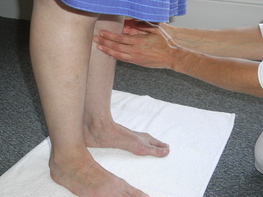Maria Chrysostomou
07730 039038
What is Vertical Reflex Therapy (VRT)?
Vertical Reflex Therapy is incorporated into a conventional reflexology treatment and is used at the beginning and/or end of the session. It is done in a standing (vertical) position, and the reflexes on the top of the feet are worked instead of the soles of the feet.
When standing we are bearing weight down onto the feet and this seems to create a more direct link between the foot reflexes and parts of the body, thereby accelerating the response. The hands can also be worked in conjunction with the feet, to create a stronger link between the two, especially when using the ‘zonal triggers’ around the ankles.
How Vertical Reflex Therapy (VRT) was developed
Lynne Booth pioneered the VRT technique when working as a reflexologist in a residential nursing home with wheelchair patients. Working on the soles of the feet was not an option for her so adapting to circumstances, she found she could get excellent results from pressing the patient’s foot firmly onto the foot rest of their wheelchair and work on the upper part of their foot.
With further work, she discovered seemingly new, or deeper reflexes on the tops of the feet and realised that weight-bearing was the key to faster results from reflexology. And so, Vertical Reflex Therapy was born!
For terms and fees click here for the reflexology page
Useful VRT links


